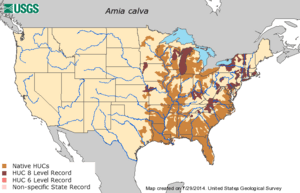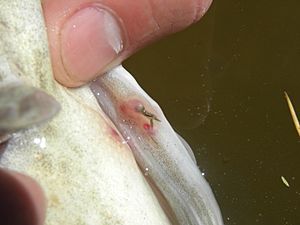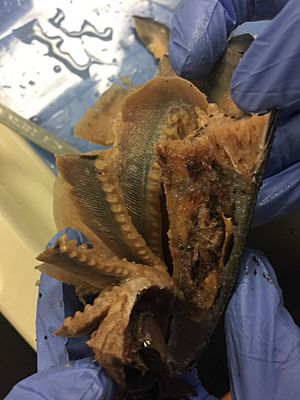Bowfin facts for kids
Quick facts for kids Bowfin |
|
|---|---|
 |
|
| Bowfin in aquarium | |
| Conservation status | |
| Scientific classification | |
| Synonyms | |
|
Genus
Amiatus Rafinesque 1815
Hypamia (Leidy 1873) Amia (Hypamia) Leidy 1873 Kindleia Jordan 1927 Protamia (Leidy 1873) Amia (Protamia) Leidy 1873 Stylomyleodon Russell 1928 Species
Amia ocellicauda Todd 1837
Amia occidentalis DeKay 1842 Amia marmorata Valenciennes 1847 Amia ornata Valenciennes 1847 Amia viridis Valenciennes 1847 Amia cinerea Valenciennes 1847 Amia reticulata Valenciennes 1847 Amia canina Valenciennes 1847 Amia lintiginosa Valenciennes 1847 Amia subcoerulea Valenciennes 1847 Amia thompsonii Duméril 1870 Amia piquotii Duméril 1870 Amiatus calvus (Linnaeus 1766) |
Bowfin (Amia calva) are ancient bony fish. They are related to gars. People call them by many names, like mudfish, dogfish, or swamp trout. Bowfin are special because they are the only living species left from a very old group of fish called Amiiformes. This group dates back to the time of dinosaurs! Even though they are very old, bowfin are highly evolved. They are often called "primitive fish" because they still have some features from their early ancestors.
Bowfin live in fresh water in North America. They are found in the eastern United States and parts of southern Canada. They like places with lots of plants, like swamps, slow rivers, and lakes. They are carnivores, meaning they eat other animals. They mostly eat fish, but also crayfish and insects. They are ambush predators, meaning they hide and then quickly attack their prey.
One amazing thing about bowfin is that they can breathe both water and air. They use their gills to breathe in water. But they also have a special organ called a gas bladder. This bladder helps them float and lets them breathe air. They can come to the surface and gulp air. This helps them survive in water with very little oxygen, which would kill most other fish.
Contents
What do Bowfin Look Like?
The average bowfin is about 50 centimeters (20 inches) long. Females usually grow to be 65–70 cm (26–28 in), while males are 50–65 cm (20–26 in). The biggest bowfin ever found was 109 cm (43 in) long and weighed 9.75 kilograms (21.5 pounds). Young bowfin grow quickly. Females tend to be larger than males.
Bowfin have a long, cylinder-shaped body. Their back and sides are olive green to brown. They often have dark patterns that help them blend in. Their belly is white or cream. Their fins are often bright green. Baby bowfin are black and look like tadpoles. As they grow, they look like tiny armored fish.
Young male bowfin have a black eyespot at the base of their tail. It often has an orange-yellow ring around it. Females might have a black eyespot, or none at all. This eyespot helps confuse predators. It makes them attack the tail instead of the head, giving the bowfin a chance to escape. The name "bowfin" comes from its long, wavy dorsal fin. This fin has many rays and runs almost the entire length of its back.
The bowfin's head is protected by 28 bones that are fused together. These bones form a strong skull. They also have sharp teeth on their jaws. A special bone called the bony gular plate is found under their head. This is one of their "primitive" features. Unlike many older fish, bowfin have large, single-layered scales. These scales are similar to those of more modern fish.
Fish That Look Like Bowfin
Sometimes, people confuse bowfin with Northern snakeheads. Both fish have long, cylinder-shaped bodies and long dorsal fins. However, northern snakeheads are an invasive species in North America. Bowfin have a black eyespot on their tail. They are tan and olive colored. They also have a shorter anal fin and a more rounded head.
The burbot is another fish sometimes mistaken for a bowfin. Burbots have a flat head and a chin barbel (a whisker-like growth). They also have a long anal fin.
How Bowfin Have Changed Over Time
Early fish did not have jaws. They sucked in their food. Over time, bowfin developed jaws. This allowed them to catch and eat bigger, more nutritious prey. Having more food helped them become more active. The bowfin's jaw can open and close powerfully. This makes them better predators.
The backbone of the bowfin is strong and bony. In earlier fish, a softer rod called a notochord provided support. The bowfin's strong backbone helps it move powerfully. It can bend its body without breaking. This allows for controlled and strong swimming. The bowfin's tail is rounded, which helps it swim faster by reducing drag. This type of tail is common in fish with gas bladders, as the bladder helps them float.
Bowfin belong to a group of fish called actinopterygii. This means their fins are mostly supported by bones. These fins help them steer, stop, and make small movements in the water. The fins are connected to the skull.
How Bowfin Bodies Work

Bowfin can breathe in two ways. They can get oxygen from the water using their gills. They can also gulp air from the surface using their gas bladder. This bladder is connected to their gut. When they are not very active, bowfin get more than half of their oxygen from breathing air. This ability helps them survive when there is not much oxygen in the water. They breathe more air when it's dark and they are more active.
Bowfin can live in warm, slightly acidic water. They become less active when the water is colder than 10°C (50°F). They breathe almost no air at this temperature. But as the water gets warmer, they breathe more air. They like temperatures between 12–26°C (54–79°F). They are most active around 18°C (64°F).
Some people have reported finding bowfin buried in mud, surviving without water for a short time. This is called aestivation. However, lab tests show they might only survive a few days out of water. Still, their gills are strong and don't collapse easily, which helps them breathe air even when exposed to it.
Bowfin Family Tree
Scientists are still learning about how bowfin and their relatives evolved. Bowfin are the only living members of a group called Halecomorphi. This group includes many fish that are now extinct. For a long time, scientists thought halecomorphs were closely related to teleost fish, which are most modern bony fish. Recent studies using genes have helped confirm this idea.
There are over 23,000 species of ray-finned fish. They are divided into two main groups. One group includes sturgeons and paddlefish. The other group, called Neopterygii, includes most modern bony fish. Bowfin and gars are part of this second group. They are considered "relict species," meaning they are the last survivors of ancient fish groups.

Types of Neopterygian Fish
Neopterygians are a big step in fish evolution. They have important changes to their jaws, skull, and tail. They are split into three main groups:
- Gars: These are ancient fish that first appeared when dinosaurs were around.
- Bowfin: The only living species in their group, which dates back to the Triassic period.
- Teleost Fish: This group includes most of the modern bony fish we see today.
Extinct and Living Bowfin Species
There are many extinct species of Amia (the genus that includes bowfin). Only one species is still alive today:
- Amia calva (the Bowfin)
What Bowfin Eat
Bowfin are stealthy hunters. They often move into shallow water at night to hunt fish, crayfish, snails, and water insects. Young bowfin eat small crustaceans. Adult bowfin mostly eat other fish. They are also opportunistic, meaning they will eat whatever they can find.
Bowfin are very quick and have a huge appetite. Their wavy dorsal fin helps them move silently through the water when they are hunting. When they attack, they move very fast, in about 0.075 seconds! Some studies have shown that bowfin can survive a long time without food. One female bowfin lived for 20 months without eating! Their bodies are not designed to eat tiny organisms like bacteria.
Where Bowfin Live

Long ago, bowfin and their relatives lived all over the world, in both fresh and salt water. Today, bowfin (Amia calva) only live in fresh water in North America. You can find them in the eastern United States and southern Canada. This includes the Mississippi River basin, the Great Lakes, and rivers along the East Coast and Gulf of Mexico.
Moving Bowfin to New Places
In the past, people sometimes moved fish, including bowfin, to new lakes and rivers. They didn't always know how this would affect the environment. Bowfin are predators. When they are introduced to new places, they can sometimes harm the native fish populations. Because of this, rules have been put in place to protect bowfin and keep ecosystems balanced.
Where Bowfin Like to Live
Bowfin prefer quiet waters with lots of plants. This includes swamps, slow-moving rivers, and lakes. They are very good at hiding. You might find them under roots or sunken logs. They can live in water with low oxygen because they can breathe air.
Bowfin Life Cycle
Bowfin lay their eggs in the spring or early summer, usually between April and June. They often do this at night in shallow, clear water with lots of plants. Males build circular nests by clearing away leaves and stems. These nests are usually 39–91 cm (15–36 in) wide and in water about 61–92 cm (24–36 in) deep.
During spawning season, the fins and belly of male bowfin turn a bright lime green. A male and female will spend one to three hours together in the nest. The female lays her eggs, and the male fertilizes them. One male might have eggs from several females in his nest. A single female might lay eggs in several nests.
Females leave the nest after laying eggs. The male stays behind to guard the eggs for about 8 to 10 days until they hatch. A nest can have 2,000 to 5,000 eggs, or even more! Larger females can lay over 55,000 eggs. The eggs are sticky and attach to plants, roots, or sand.
After hatching, baby bowfin don't swim much. For about 7 to 9 days, they attach to plants using a special organ on their snout. The father bowfin protects them during this time. Bowfin fathers are very protective of their young. When the young fish can swim and find food on their own, they form a school. The father bowfin swims around them to keep them safe.
Bowfin become adults and can reproduce when they are two to three years old. They can live for 10 to 12 years in the wild. In aquariums, they can live up to 30 years! Females usually live longer than males.
Bowfin Health

Bowfin can get sick. A common parasite is the anchor worm. These tiny creatures attach to the fish's skin and fins. They can make the fish grow slower or even die. Also, a type of clam called Megalonaias gigantea lays its eggs in the gills of bowfin. The baby clams then grow there.
Bowfin have also been known to get certain diseases, like some types of cancer.
Bowfin and People
Many anglers (people who fish for sport) don't consider bowfin a desirable catch. In the past, some thought bowfin were a nuisance because they eat other fish. People even tried to reduce their numbers. However, research has shown that bowfin are important for healthy ecosystems. Now, there are rules to protect them. Bowfin are strong fighters, which is a good quality for a game fish. But they have sharp teeth, so you need to be careful when handling them. The record for a caught bowfin is 9.75 kg (21.5 lb).
Bowfin meat was once thought to be not very good. It was described as "soft" and "bland." But if it's prepared correctly, like by smoking it or frying it, it can be tasty.
Because of strict rules on catching sturgeon (which produce expensive caviar), bowfin eggs have become a popular substitute. In Louisiana, bowfin are caught in the wild and raised on farms for their meat and eggs. Their eggs are made into caviar and sold as "Cajun caviar."
Harmful Chemicals in Bowfin
In some areas, water can have high levels of harmful chemicals like mercury. Signs are often posted to warn people about eating fish from these areas. Mercury builds up in the food chain. It gets more concentrated in bigger, older fish that eat other fish. Bowfin tend to have higher levels of mercury than smaller fish. This means they might be less safe for people to eat in polluted areas.
Images for kids
See also
 In Spanish: Amia calva para niños
In Spanish: Amia calva para niños







